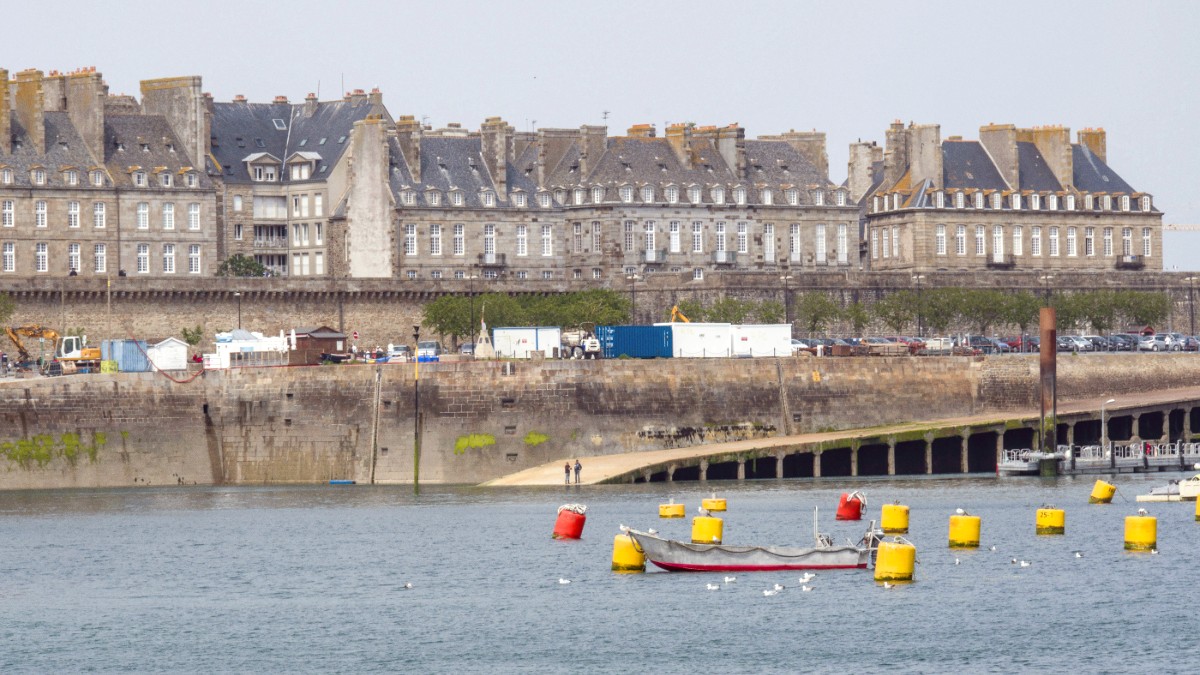
Brittany, France
Saint-Malo experiences a temperate oceanic climate, meaning mild temperatures year-round, with rainfall distributed across all seasons. Its coastal position means weather often changes quickly. Temperatures generally avoid extremes, allowing comfortable exploration for much of the year.
Humidity consistently ranges from 75% to 85% due to Saint-Malo's coastal location. This high humidity makes cooler days feel damp and warmer days feel muggier. There is no truly dry season, so always prepare for the possibility of rain.
Saint-Malo's coastal exposure means it experiences strong winds, especially during autumn and winter storms. These winds make walking along the ramparts or exposed coastal paths less comfortable. The city also experiences one of the highest tidal ranges in Europe. This natural phenomenon not only offers a spectacle; it changes access to beaches, tidal islands like Grand Bé and Fort National, and even some coastal walking routes.
Always consult local tide tables. These are widely available online, at the tourist office, and often displayed at beach access points. Accessing tidal islands without checking tides presents a hazard.
Warmest weather, lively atmosphere.
Ideal for beaches & outdoor activities, all services fully operational, numerous events.
Highest prices, substantial crowds, advance bookings for everything needed, difficult parking.
Mild weather, fewer crowds.
Pleasant temperatures for sightseeing, fewer crowds, lower accommodation prices, many activities operational.
Less predictable weather, higher rain chance, some smaller establishments with reduced hours in late autumn.
Fewest crowds, quiet experience.
Lowest prices, intimate city experience, local life without tourist rush, dramatic coastal scenery.
Coldest and wettest weather, many tourist establishments closed or limited hours, outdoor activities less pleasant.
For beach activities and swimming, July and August offer the warmest water temperatures and most sunshine. May, June, and September provide comfortable temperatures and fewer crowds than the peak summer, excellent for exploring the ramparts and coastal paths on foot or by bike. The shoulder season (April-June, September-October) presents a good balance for enjoying the walled city with fewer crowds, while low season offers a quiet, contemplative experience.
Tide pooling and Fort National access depend entirely on low tide. You can do them year-round, but you must check the local tide tables to plan your visit precisely. Guided tours of Fort National are only possible at specific low tide windows. If specific events like the Route du Rhum (every four years) or Etonnants Voyageurs literary festival (May/June) interest you, plan your visit around their specific dates. These events draw large crowds and booking accommodations in advance is a good idea.
July, August.
May, June, September.
April-June, September-October.
Year-round, based on tide tables.
Check specific event calendars.
France is a member of the Schengen Area, a group of 27 European countries that have abolished passport and border controls at their common borders. This means that once you enter the Schengen Area, travel freely among member states without further immigration checks.
Citizens of EU, EEA, or Swiss countries do not require a visa. Many other nationalities are visa-exempt for short stays up to 90 days (tourism, business, visiting family/friends).
Regardless of visa needs, certain documents are universally for entry into France and the Schengen Area.
France does not charge a general entry fee for tourists. Upon arrival at your first point of entry into the Schengen Area (which might be a different country than France), you go through passport control. Immigration officers verify your passport and visa (if applicable) and ask about the purpose and duration of your visit. This process is standard and generally efficient.
For general tourism in Saint-Malo and the surrounding areas, no special permits are needed. You can freely explore the walled city, beaches, and nearby towns. Different long-stay visas or permits may apply for specialized activities like scientific research or extended work, but these are outside the scope of typical tourism.
Required for Schengen visa applicants; strongly for others. World Nomads, SafetyWing, Insubuy are options.
Recent passport-sized photos meeting Schengen requirements (3.5cm x 4.5cm, white background).
Keep both printed and digital copies of all important documents. Store them separately.
Ensure MMR, DTP, Varicella, Polio, and Flu are up-to-date.
A doctor's note for prescription medications (especially controlled substances) helps.
Here's a breakdown of currency, expected costs, and money-saving strategies.
France uses the Euro (€). Euros are in banknotes (€5 to €500) and coins (1 cent to €2).
Tipping customs in France differ from some other countries. A service charge ("service compris") is included in restaurant and cafe bills by law, typically around 15%. This means you are not obliged to leave an additional tip.
Prices can vary significantly by season, location, and specific choices.